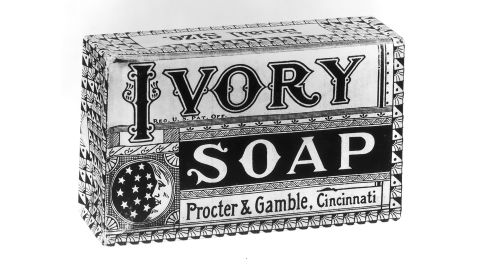New York
CNNBusiness
—
Walk into a Walmart, Target, any drugstore chain in your neighborhood or a corner bodega for New York City dwellers, and chances are you’ll find an Ivory Soap bar, or a pack of 10 bars for under $5, sitting on the shelf.
This iconic cake of soap, invented almost 150 years ago, has become a part of Americana largely by advertising its two strange merits: “It Floats” and it’s “99+44⁄100% Pure.”
The original product is a no-frills, plain white, mild-scented bar soap with the name “IVORY” etched into it in script. Impressively, it has stayed exactly that way for 143 years – barring the addition of an Aloe scented variety, and is also still around.
Ivory soap’s longevity flies in the face of a notoriously fickle market for personal beauty products where new trends can appear and disappear in a flash.
So why has Ivory Soap stood the test of time? One theory is because of its clever advertising and branding. Ivory Soap packaging famously, and relentlessly, touts the attributes of purity and buoyancy.
“That’s brilliant execution,” said David Placek, founder of Lexicon Branding, a branding expert who has helped name such popular consumer products as “Swiffer,” “Blackberry” and “Dasani.”
“Just think about it. How many other soaps can you think of that tout an attribute that’s analogous to “It Floats?” said Placek. “I can’t think of another. It makes you remember it because it also makes you think about other soaps that don’t float.”
Because Ivory Soap’s taglines have remained consistent and endured for over a century and through generations of consumers, they’ve seeped into the subconscious, said Placek.
“Even if you’ve not used Ivory Soap you know about it and you remember it,” he said.
Ivory Soap is the brainchild of Procter & Gamble. Not the huge multinational consumer brands conglomerate that it is today, but of two individuals – Harley Procter (son of P&G cofounder William Procter) and James N. Gamble (son of P&G’s other cofounder, James Gamble).
It was in the late 19th century, a period when river bathing was prevalent among large swaths of the population. Now imagine losing your grip on a bar of soap when you’re immersed waist-deep in murky water.
But what if there was a soap bar that could float?

An AdAge article about Ivory Soap’s invention explained how Gamble at the time was trying to create a new type of gently formulated soap. The R&D process inadvertently created a batch of soap that was found to float because air bubbles got trapped inside.
Gamble, according to P&G’s website, recognized the “floating soap” could revolutionize the washing experience in more ways than one.
He initially thought the floating soap could be used both for laundry and for washing up. Over time, the soap bar primarily became a bath soap.
Naming the soap was another story.
According to P&G legend, Harley Procter came upon the word “ivory” while attending church and thought it perfectly fit the new soap’s look and feel and both men adopted “Ivory Soap” as the name.

P&G launched the soap in 1879 hyping it not only as a soap bar that floated but for its purity.
That claim, according to the company, hinged on a study of the soap by chemistry professors at the request of the inventors. One study showed the soap had only a small amount of impurities – 56/100 of a percent – of non-soap material in it.
So they decided to play that up in Ivory Soap’s advertising, rounding it up to create its second iconic tagline – “99 and 44-100% pure.”
P&G maintains that while it continues to innovate its Ivory Soap, the product is still made with a simple formula free of dyes and parabens meant to gently cleanse the skin.
It has, however, extended the brand to other products.

In the 1950s, according to the AdAge article, P&G launched a light-duty dishwashing detergent under the Ivory brand, followed by liquid hand soaps in the 1980s and moisturizing body washes in 1996 with the introduction of Ivory Moisture Care. Today, the Ivory personal care portfolio also includes baby care products, hair and body washes and deodorant.
Ivory soap has become so iconic that in 2001 P&G donated a collection of its Ivory Soap artifacts to the Smithsonian Institution, including its earliest advertising and a bar of unused soap from the 1940s.
Lexicon Branding’s Placek said Ivory Soap is a product way ahead of its time. “It was ‘pure’ before pure, clean and simple products became as popular as they are with consumers today,” he said.
 Milon Shil All About Entertainment, Lander World
Milon Shil All About Entertainment, Lander World